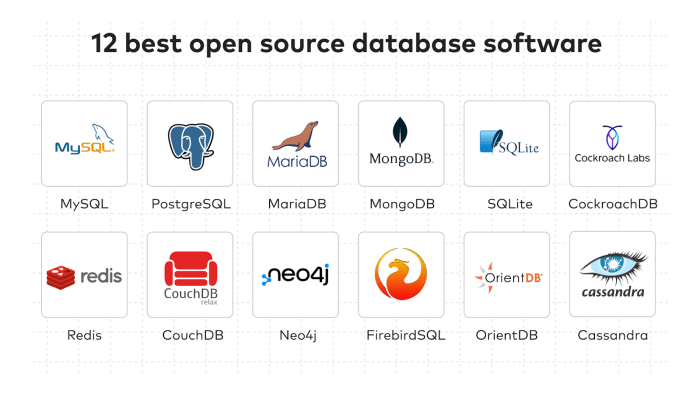Comparison of Popular Database Management Software

Best software for database management – When selecting a database management software (DBMS), it is crucial to consider the specific requirements of your organization. Different DBMS options excel in different areas, and understanding their strengths, weaknesses, and pricing can help you make an informed decision.
Key Differences Between Popular DBMS Options
The following table summarizes the key differences between some popular DBMS options:
| Feature | MySQL | PostgreSQL | Oracle | Microsoft SQL Server | IBM Db2 |
|---|---|---|---|---|---|
| Open Source | Yes | Yes | No | No | No |
| Cost | Free | Free | Paid | Paid | Paid |
| Scalability | High | High | Very High | Very High | Very High |
| Performance | Good | Excellent | Excellent | Excellent | Excellent |
| Security | Good | Excellent | Excellent | Excellent | Excellent |
| Ease of Use | Good | Good | Fair | Good | Fair |
| Features | Comprehensive | Comprehensive | Very Comprehensive | Very Comprehensive | Very Comprehensive |
Choosing the Right Database Management Software: Best Software For Database Management

Selecting the appropriate database management software (DBMS) is crucial for businesses to effectively manage their data and meet their specific requirements. To make an informed decision, businesses should consider several factors and follow a systematic approach.
Factors to Consider, Best software for database management
- Data Size and Complexity:Determine the volume and complexity of data to be managed, as this will influence the software’s scalability and performance requirements.
- Data Types:Identify the types of data that will be stored, such as structured, unstructured, or semi-structured, as different DBMSs specialize in handling specific data types.
- Concurrency and Performance:Consider the number of simultaneous users and the required performance levels for data access and processing.
- Security and Compliance:Evaluate the security features of the DBMS, including data encryption, access control, and compliance with industry regulations.
- Scalability and Flexibility:Assess the software’s ability to handle future growth in data volume and complexity, as well as its flexibility to adapt to changing business needs.
- Cost and Licensing:Determine the upfront and ongoing costs associated with the DBMS, including licensing fees, maintenance, and support.
- Technical Expertise:Evaluate the level of technical expertise required to implement and manage the DBMS, considering the available resources within the organization.
Best Practices for Database Management
Database management involves a range of practices to ensure data integrity, security, and performance. By adhering to these best practices, organizations can maximize the value of their data and optimize database operations.
Effective database management encompasses:
Data Backup and Recovery
- Implement a comprehensive backup strategy that includes regular backups to multiple locations.
- Test backup procedures regularly to ensure data recovery in case of system failures or data loss.
Security Measures
- Establish access controls and user permissions to prevent unauthorized access to sensitive data.
- Implement encryption techniques to protect data both in transit and at rest.
- Regularly audit database activity to detect suspicious or malicious behavior.
Performance Optimization
Database performance is crucial for efficient operations. Here are some tips to optimize database performance:
- Regularly monitor database performance metrics such as query execution time and resource usage.
- Identify and optimize slow-running queries to improve query performance.
- Implement caching mechanisms to reduce the load on the database server.
- Use appropriate indexing techniques to speed up data retrieval.
- Consider sharding or partitioning large databases to distribute data across multiple servers.


